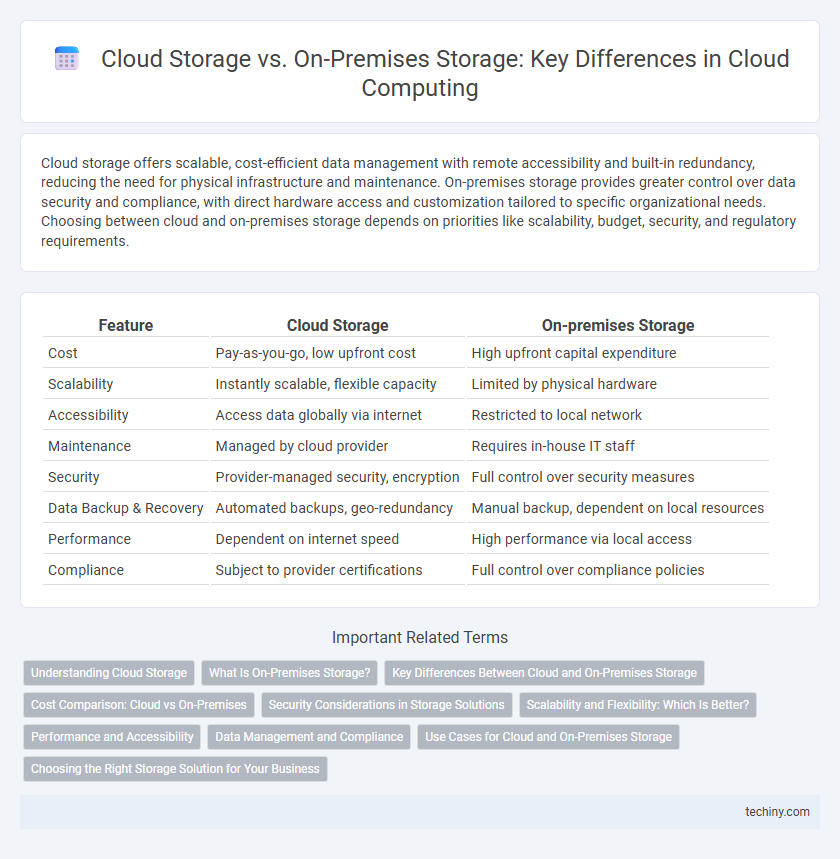Cloud storage offers scalable, cost-efficient data management with remote accessibility and built-in redundancy, reducing the need for physical infrastructure and maintenance. On-premises storage provides greater control over data security and compliance, with direct hardware access and customization tailored to specific organizational needs. Choosing between cloud and on-premises storage depends on priorities like scalability, budget, security, and regulatory requirements.
Table of Comparison
| Feature | Cloud Storage | On-premises Storage |
|---|---|---|
| Cost | Pay-as-you-go, low upfront cost | High upfront capital expenditure |
| Scalability | Instantly scalable, flexible capacity | Limited by physical hardware |
| Accessibility | Access data globally via internet | Restricted to local network |
| Maintenance | Managed by cloud provider | Requires in-house IT staff |
| Security | Provider-managed security, encryption | Full control over security measures |
| Data Backup & Recovery | Automated backups, geo-redundancy | Manual backup, dependent on local resources |
| Performance | Dependent on internet speed | High performance via local access |
| Compliance | Subject to provider certifications | Full control over compliance policies |
Understanding Cloud Storage
Cloud storage leverages remote servers hosted on the internet to store, manage, and back up data, offering scalability and accessibility from any location with an internet connection. Unlike on-premises storage, which requires physical hardware and maintenance within a company's infrastructure, cloud storage reduces capital expenditure and provides automated data redundancy and disaster recovery options. Key cloud storage providers like Amazon S3, Google Cloud Storage, and Microsoft Azure offer robust security features and pay-as-you-go pricing models, enabling businesses to optimize costs and improve operational agility.
What Is On-Premises Storage?
On-premises storage refers to data storage solutions located within an organization's physical premises, managed and maintained by the internal IT team. This approach provides enhanced control over data security, access, and compliance but requires significant upfront investment in hardware and ongoing maintenance costs. Organizations often choose on-premises storage to meet strict regulatory requirements or when low latency access to data is critical for operations.
Key Differences Between Cloud and On-Premises Storage
Cloud storage offers scalable, pay-as-you-go solutions with remote accessibility and automated backups, whereas on-premises storage requires upfront hardware investment with physical maintenance and limited remote access. Cloud storage ensures high availability through distributed data centers, contrasting with on-premises storage that depends on local infrastructure and in-house IT management. Security models differ as cloud storage relies on provider-managed encryption and compliance frameworks, while on-premises storage offers direct control over data protection measures and policies.
Cost Comparison: Cloud vs On-Premises
Cloud storage typically offers lower upfront costs compared to on-premises storage, as it eliminates the need for heavy capital investments in hardware and infrastructure. Ongoing expenses for cloud storage include subscription fees and data transfer costs, whereas on-premises storage incurs maintenance, power, cooling, and upgrade expenses that often increase total cost of ownership. Organizations should consider scalability requirements, data security policies, and long-term usage patterns to determine the most cost-effective option between cloud and on-premises storage solutions.
Security Considerations in Storage Solutions
Cloud storage offers advanced encryption protocols and continuous security updates managed by providers, reducing the risk of data breaches compared to on-premises storage. On-premises storage requires organizations to implement and maintain robust physical and network security measures, potentially leading to higher vulnerability due to limited resources. Compliance with regulations such as GDPR and HIPAA can be more easily enforced through cloud providers' standardized security certifications and audit trails.
Scalability and Flexibility: Which Is Better?
Cloud storage offers superior scalability by allowing seamless expansion of storage capacity on demand without upfront hardware investments, accommodating fluctuating workloads effortlessly. On-premises storage, while providing direct control and customization, often faces limitations in scalability due to physical hardware constraints and longer provisioning times. Flexibility in cloud storage is enhanced through automated management, global accessibility, and integration with diverse cloud services, whereas on-premises solutions require manual configurations and are confined to the local infrastructure.
Performance and Accessibility
Cloud storage offers scalable performance with high-speed access through distributed data centers, enabling seamless global accessibility and reduced latency compared to traditional on-premises storage. On-premises storage provides consistent performance for local workloads but can suffer from limited accessibility and higher latency for remote users. Hybrid architectures often combine cloud scalability and accessibility with the control and low-latency benefits of on-premises systems.
Data Management and Compliance
Cloud storage offers scalable data management solutions with automated compliance features aligned to standards such as GDPR, HIPAA, and SOC 2, enabling real-time monitoring and audit trails. On-premises storage provides greater direct control over data governance and security policies but requires significant resources for regulatory compliance and manual data management. Enterprises balance compliance needs with operational flexibility by integrating cloud storage's advanced encryption and support for data residency requirements, while maintaining critical workloads on-premises.
Use Cases for Cloud and On-Premises Storage
Cloud storage excels in scalability and remote accessibility, making it ideal for dynamic workloads, disaster recovery, and collaboration across geographically dispersed teams. On-premises storage offers enhanced control, security, and low-latency access, suiting sensitive data environments, regulatory compliance needs, and applications requiring high-performance computing. Hybrid architectures often combine both solutions to optimize cost efficiency, flexibility, and security for diverse enterprise use cases.
Choosing the Right Storage Solution for Your Business
Choosing the right storage solution involves evaluating factors such as scalability, cost, security, and accessibility. Cloud storage offers flexible scalability and reduced upfront costs, ideal for businesses with fluctuating data needs. On-premises storage provides greater control and security, which can be crucial for organizations with strict compliance requirements or sensitive data.
Cloud Storage vs On-premises Storage Infographic

 techiny.com
techiny.com